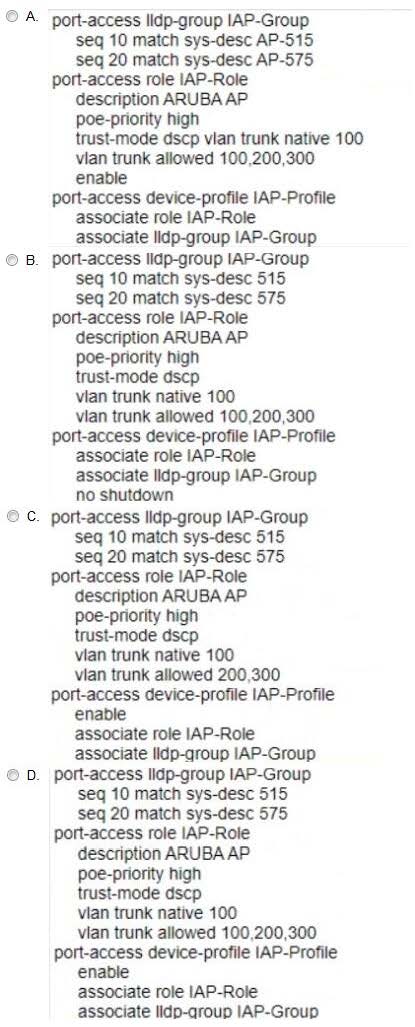Exam Details
Exam Code
:HPE7-A01Exam Name
:Aruba Certified Campus Access ProfessionalCertification
:HP CertificationsVendor
:HPTotal Questions
:119 Q&AsLast Updated
:Mar 29, 2025
HP HP Certifications HPE7-A01 Questions & Answers
-
Question 11:
What is true regarding 802.11k?
A. It extends radio measurements to define mechanisms for wireless network management of stations
B. It reduces roaming delay by pre-authenticating clients with multiple target APs before a client roams to an AP
C. It provides mechanisms for APs and clients to dynamically measure the available radio resources.
D. It considers several metrics before it determines if a client should be steered to the 5GHz band, including client RSSI
-
Question 12:
Your customer is having issues with Wi-Fi 6 clients staying connected to poor-performing APs when a higher throughput APs are closer. Which technology should you implement?
A. Clearpass
B. ClientMatch
C. Airmatch
D. ARM
-
Question 13:
On AOS10 Gateways, which device persona is only available when configuring a Gateway- only group'?
A. Edge
B. Mobility
C. Branch
D. VPN Concentrator
-
Question 14:
For the Aruba CX 6400 switch, what does virtual output queueing (VOQ) implement that is different from most typical campus switches?
A. large ingress packet buffers
B. large egress packet buffers
C. per port ASICs
D. VSX
-
Question 15:
A company recently deployed new Aruba Access Points at different branch offices Wireless 802.1X authentication will be against a RADIUS server in the cloud. The security team is concerned that the traffic between the AP and the RADIUS server will be exposed.
What is the appropriate solution for this scenario?
A. Enable EAP-TLS on all wireless devices
B. Configure RadSec on the AP and Aruba Central.
C. Enable EAP-TTLS on all wireless devices.
D. Configure RadSec on the AP and the RADIUS server
-
Question 16:
Which standard supported by some Aruba APs can enable a customer to accurately locate wireless client devices within a few meters?
A. 802.11mc
B. 802.11W
C. 802.11k
D. 802.11r
-
Question 17:
A system engineer needs to preconfigure several Aruba CX 6300 switches that will be sent to a remote office An untrained local field technician will do the rollout of the switches and the mounting of several AP-515s and AP-575S. Cables running to theAPs are not labeled.
The VLANs are already preconfigured to VLAN 100 (mgmt), VLAN 200 (clients), and VLAN 300 (guests)
What is the correct configuration to ensure that APs will work properly?

A. Option A
B. Option B
C. Option C
D. Option D
-
Question 18:
A customer wants to provide wired security as close to the source as possible The wired security must meet the following requirements: -allow ping from the IT management VLAN to the user VLAN -deny ping sourcing from the user VLAN to the IT management VLAN The customer is using Aruba CX 6300s What is the correct way to implement these requirements?
A. Apply an outbound ACL on the user VLAN allowing temp echo-reply traffic toward the IT management VLAN
B. Apply an inbound ACL on the user VLAN allowing icmp echo-reply traffic toward the IT management VLAN
C. Apply an inbound ACL on the user VLAN denying icmp echo traffic toward the IT management VLAN
D. Apply an outbound ACL on the user VLAN denying icmp echo traffic toward the IT management VLAN
-
Question 19:
A customer is using Aruba Cloud Guest, but visitors keep complaining that the captive portal page keeps coming up after devices go to sleep. Which solution should be enabled to deal with this issue?
A. MAC Caching under the splash page
B. MAC Caching under the user-role
C. Wireless Caching under the splash page
D. MAC Caching under the WLAN
-
Question 20:
A company deployed Dynamic Segmentation with their CX switches and Gateways After performing a security audit on their network, they discovered that the tunnels built between the CX switch and the Aruba Gateway are not encrypted. The company is concerned that bad actors could try to insert spoofed messages on the Gateway to disrupt communications or obtain information about the network.
Which action must the administrator perform to address this situation?
A. Enable Secure Mode Enhanced
B. Enable Enhanced security
C. Enable Enhanced PAPI security D. Enable GRE security
Related Exams:
HP0-D15
Administering HP CloudSystem Matrix SolutionsHP0-D20
Architecting the HP Matrix Operating EnvironmentHP2-E56
Selling HP SMB SolutionsHP2-H88
Selling HP Business Personal Systems Hardware 2019HP2-I14
Selling HP Supplies 2020HP2-I15
Selling HP Business Personal Systems Hardware 2020HP2-I17
Selling HP Printing Hardware 2020HP2-I44
Selling HP Workstations 2022HP2-I73
Selling HP Retail and Hospitality Solutions 2024HP2-N51
HP Application Lifecycle Management 12.x Software
Tips on How to Prepare for the Exams
Nowadays, the certification exams become more and more important and required by more and more enterprises when applying for a job. But how to prepare for the exam effectively? How to prepare for the exam in a short time with less efforts? How to get a ideal result and how to find the most reliable resources? Here on Vcedump.com, you will find all the answers. Vcedump.com provide not only HP exam questions, answers and explanations but also complete assistance on your exam preparation and certification application. If you are confused on your HPE7-A01 exam preparations and HP certification application, do not hesitate to visit our Vcedump.com to find your solutions here.